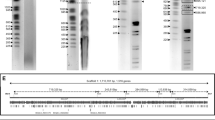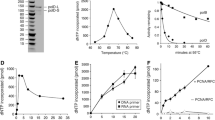Abstract
The molecular characterization of an additional DNA species (pAL2-1) which was identified previously in a long-lived extrachromosomal mutant (AL2) of Podospora anserina revealed that this element is a mitochondrial linear plasmid. pAL2-1 is absent from the corresponding wild-type strain, has a size of 8395 bp and contains perfect long terminal inverted repeats (TIRs) of 975 bp. Exonuclease digestion experiments indicated that proteins are covalently bound at the 5′ termini of the plasmid. Two long, non-overlapping open reading frames, ORF1 (3,594 bp) and ORF2 (2847 bp), have been identified, which are located on opposite strands and potentially encode a DNA and an RNA polymerase, respectively. The ORF1-encoded polypeptide contains three conserved regions which may be responsible for a 3′–5′ exonuclease activity and the typical consensus sequences for DNA polymerases of the D type. In addition, an amino-acid sequence motif (YSRLRT), recently shown to be conserved in terminal proteins from various bacteriophages, has been identified in the amino-terminal part of the putative protein. According to these properties, this first linear plasmid identified in P. anserina shares all characteristics with invertrons, a group of linear mobile genetic elements.
Similar content being viewed by others
References
Akins RA, Kelley RL, Lambowitz AM (1986) Cell 47: 505–516
Aleström P, Akusjarvi G, Petterson M, Petterson U (1982) J Biol Chem 257: 13492–13498
Almasan A, Mishra NC (1990) Nucleic Acids Res 18: 5871–5877
Belcour L, Begel O, Mosse MO, Vierny C (1981) Curr Genet 3: 13–21
Belcour L, Vierny C (1986) EMBO J 5: 609–614
Bernad A, Zaballos A, Salas M, Blanco L (1987) EMBO J 6: 4219–4225
Bernad A, Blanco L, Lazaro JM, Martin G, Salas M (1989) Cell 59: 219–228
Bertrand H, Chan BSS, Griffiths AJF (1985) Cell 41: 877–884
Blanco L, Bernad A, Blasco MA, Salas M (1991) Gene 100: 27–38
Chan BSS, Court DA, Vierula J, Bertrand H (1991) Curr Genet 20: 225–237
Court DA, Bertrand H (1991) Nucleic Acids Res 19: 1714
Court DA, Griffiths AJF, Kraus SR, Russell PJ, Bertrand H (1991) Curr Genet 19: 129–137
Cummings DJ, Belcour L, Grandchamp C (1979) Mol Gen Genet 171: 239–250
Cummings DJ, MacNeil IA, Domenico JM, Matsuura ET (1985) J Mol Biol 185: 659–680
Dale RWK, McClure BA, Houchins JP (1985) Plasmid 13: 31–40
Escarmis C, Salas M (1982) Nucleic Acids Res 10: 5785–5798
Esser K (1974) In: King RC (ed) Handbook of genetics, vol I. Plenum Press, New York, pp 531–551
Esser K (1985) In: Bergener M, Ermini M, Stähelin HB (eds) The 1984 Sandoz Lectures in Gerontology. Thresholds in aging. Academic Press, London, pp 3–20
Esser K, Kück U, Lang-Hinrichs C, Lemke P, Osiewacz HD, Stahl U, Tudzynski P (1986) Plasmids of eukaryotes. Springer Verlag, Berlin Heidelberg New York Tokyo
Fisher RP, Clayton DA (1988) Mol Cell Biol 8: 3496–3509
Fox TD (1987) Annu Rev Genet 21: 67–91
Gessner-Ulrich K, Tudzynski P (1992) Curr Genet 21: 249–254
Henikoff S (1984) Gene 28: 351–359
Hishinuma F, Hirai K (1991) Mol Gen Genet 226: 97–106
Hishinuma F, Nakamura K, Hirai K, Nishizawa R, Gunge N, Maeda T (1984) Nucleic Acids Res 12: 7581–7597
Horvitz MS (1990) In: Fields BN, Knipe DM et al. (eds) Virology, 2nd edn. Raven Press Ltd., New York
Hsieh J-C, Jung G, Eavitt MC, Ito J (1987) Nucleic Acids Res 15: 8999–9009
Hsieh J-C, Yoo S-K, Ito J (1990) Proc Natl Acad Sci USA 87: 8665–8669
Jung G, Leavitt MC, Ito J (1987) Nucleic Acids Res 15: 9088
Kelley JL, Lehman IR (1986) J Biol Chem 261: 10340–10347
Kempken F, Meinhardt F, Esser K (1989) Mol Gen Genet 218: 523–530
Kempken F, Hermanns J, Osiewacz HD (1992) J Mol Evol (in press)
Kotani H, Ishizaki Y, Hiraoka N, Obayashi A (1987) Nucleic Acids Res 15: 2657–2664
Kruse B, Narasimhan N, Attardi G (1989) Cell 58: 391–397
Kück U (1989) Exp Mycol 13: 111–120
Kück U, Stahl U, Esser K (1981) Curr Genet 3: 151–156
Kück U, Osiewacz HD, Schmidt U, Kappelhoff B, Schulte E, Stahl U, Esser K (1985) Curr Genet 9: 373–382
Kuzmin EV, Levchenko JV (1987) Nucleic Acids Res 15: 6758
Kuzmin EV, Levchenko JV, Zaitseva GN (1988) Nucleic Acids Res 16: 4177
Leavitt MC, Ito J (1987) Nucleic Acids Res 15: 5251–5259
Maniatis T, Fritsch EF, Sambrook J (1982) Cold Spring Harbor Laboratory, Cold Spring Harbor, New York
Marcou D (1961) Ann Sci Nat Bot 12: 653–764
Masters BS, Stohl LL, Clayton DA (1987) Cell 51: 89–99
McGraw NJ, Bailey JN, Cleaves GR, Dembinski DR, Gocke CR, Joliffe LK, MacWright RS, McAllister WT (1985) Nucleic Acids Res 13: 6753–6766
Meinhardt F, Kempken F, Kämper J, Esser K (1990) Curr Genet 17: 89–95
Mizukami Y, Sekiya T, Hirokawa H (1986) Gene 42: 231–235
Nargang FE, Bell JE, Strohl LL, Lambowitz AM (1984) Cell 38: 441–453
Oeser B, Tudzynski P (1989) Mol Gen Genet 217: 132–140
Osiewacz HD (1990) Mut Res 237: 1–8
Osiewacz HD, Esser K (1984) Curr Genet 8: 299–305
Osiewacz HD, Hermanns J, Marcou D, Triffi M, Esser K (1989) Mut Res 219: 9–15
Paillard M, Sederhoff RR, Levings III CSL (1985) EMBO J 4: 1125–1128
Paces V, Vlcek C, Urbanek P, Hostomsky Z (1985) Gene 38: 45–56
Pring DR, Levings III CS, Hu WWL, Timothy DH (1977) Proc Natl Acad Sci USA 7: 2904–2908
Robison M, Royer JC, Horgen PA (1991) Curr Genet 19: 495–502
Rohe M, Schrage K, Meinhardt F (1991) Curr Genet 20: 527–533
Sakaguchi K (1990) Microbiol Rev 54: 66–74
Sanger F, Nicklen S, Coulsen AR (1977) Proc Natl Acad Sci USA 74: 2611–2615
Salas M (1988a) In: Calendar R (ed) The bacteriophages, vol 1. Plenum Press, New York London, pp 169–191
Salas M (1988b) Curr Topics Microbiol Immunol 136: 69–88
Sambrook J, Fritsch EF, Maniatis T (1989) Cold Spring Harbor Laboratory, Cold Spring Harbor, New York
Savilathi H, Bamford DH (1987) Gene 57: 121–130
Schinkel AH, Groot Koerkamp MJA, Touw EPW, Tabak HF (1987) J Biol Chem 262: 12785–12791
Schulte E, Kück U, Esser K (1988) Mol Gen Genet 211: 342–349
Schulte E, Kück U, Esser K (1989) Plasmid 21: 79–84
Smart JE, Stillman BW (1982) J Biol Chem 257: 13499–13506
Sor F, Fukuhara H (1985) Curr Genet 9: 147–155
Stahl U, Lemke PA, Tudzynski P, Kück U, Esser K (1978) Mol Gen Genet 162: 341–343
Stam JC, Kwakman J, Meijer M, Stuitje AR (1986) Nucleic Acids Res 17: 6871–6884
Stark MJR, Boyd AJ (1986) EMBO J 5: 1995–2002
Stark MJR, Mileham AJ, Romanos MA, Boyd A (1984) Nucleic Acids Res 12: 6011–6030
Tommasino M, Ricci S, Galeotti CL (1988) Nucleic Acids Res 16: 5863–5878
Tudzynski P, Esser K (1979) Mol Gen Genet 173: 71–84
Tudzynski P, Stahl U, Esser K (1982) Curr Genet 6: 219–222
Vierula PJ, Cheng CK, Court DA, Humphrey RW, Thomas DY, Bertrand H (1990) Curr Genet 17: 195–201
Yanish-Perron C, Vieira J, Messing J (1985) Gene 33: 103–119
Yoshikawa H, Ito J (1982) Gene 17: 323–335
Author information
Authors and Affiliations
Additional information
Communicated by K. Esser
Rights and permissions
About this article
Cite this article
Hermanns, J., Osiewacz, H.D. The linear mitochondrial plasmid pAL2-1 of a long-lived Podospora anserina mutant is an invertron encoding a DNA and RNA polymerase. Curr Genet 22, 491–500 (1992). https://doi.org/10.1007/BF00326415
Received:
Accepted:
Issue Date:
DOI: https://doi.org/10.1007/BF00326415




